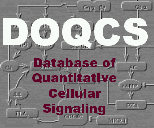 |  |  AC AC |
Enter a Search String | | Special character and space not allowed in the query term.
Search string should be at least 2 characters long. |
| | Kd is calculated only for second order reactions, like nA+nB <->nC or nA<->nC+nD, where n is number and A,B,C,D are molecules, where as for first order reactions Keq is calculated. Kd for higher order reactions is not considered. |
| | Name | Kf | Kb | Kd | tau | Substrate | Product | | 1 |
Ras-act-craf | 24
(uM^-1 s^-1) | 0.5
(s^-1) | Kd(bf) = 0.0208(uM) | - | craf-1*
GTP-Ras
| Raf-GTP-Ras*
| | | Assume binding is fast and limited only by available Ras*. So kf = kb/[craf-1] If kb is 1/sec, then kf = 1/0.2 uM = 1/(0.2 * 6e5) = 8.3e-6 Later: Raise it by 10 X to about 1e-4, giving a Kf of 60 for Kb of 0.5 and a tau of approx 2 sec. Based on: Hallberg et al JBC 269:6 3913-3916 1994, 3% of cellular Raf is complexed with Ras. This step needed to memb-anchor and activate Raf: Leevers et al Nature 369 411-414. Also see Koide et al 1993 PNAS USA 90(18):8683-8686 | | 2 |
remove_glu | 500
(s^-1) | 1000
(s^-1) | Keq = 2(uM) | 0.001sec | Glu
| synapse
| | | This reaction doubles for arrival as well as removal of glu from the synapse. Assume tau for removal of glu is ~1 msec. We know that diffusion time for arrival of glu from presynaptic side is < 50 usec. Most of the actual synaptic delay has to do with binding to the receptors. |
Pathway Details Molecule List Enzyme List Reaction List
| Database compilation and code copyright (C) 2022, Upinder S. Bhalla and NCBS/TIFR
This Copyright is applied to ensure that the contents of this database remain freely available. Please see FAQ for details. |
|
